Edinburgh low traffic scheme: Corstorphine Connects 'has not cut traffic but has reduced walking and cycling'
and live on Freeview channel 276
Campaigners against a controversial Edinburgh traffic scheme say it has failed to achieve its objectives of reducing traffic congestion and promoting active travel.
They claim that after six months the Corstorphine low traffic neighbourhood (LTN) has resulted in an increase of up to 70 per cent in traffic on some roads and fewer people walking and cycling. And they say rather than reduce traffic overall, it has instead displaced traffic to surrounding streets.


Advertisement
Hide AdAdvertisement
Hide AdThe Accessible Corstorphine for Everyone (ACE) group analysed council data on the effect of the scheme, known as Corstorphine Connections, and claimed it had found "alarming trends".
The group said on traffic Increases, several roads had seen notable spikes in traffic volumes, ranging from 18 per cent to a "staggering" 70 per cent.
And it continued: "Despite claims that the LTN would bring an overall decrease in traffic volumes within the LTN area, there is no evidence to support this claim. Instead, the data suggests that traffic has been displaced to other streets within the LTN and surrounding boundary streets, exacerbating congestion issues.
"Contrary to the scheme's objectives of encouraging walking and cycling, there has been a concerning decrease in these modes of active travel within the project area. These findings underscore a critical shortfall in the Corstorphine Connections LTN scheme's effectiveness, raising questions about its implementation strategy and impact on the community. The data clearly indicates that the Corstorphine Connections LTN has not delivered on its promised objectives."
Advertisement
Hide AdAdvertisement
Hide AdThe scheme was introduced in May, but there has been controversy since the start, particularly over the bus gate at the junction of Manse Road with St John's Road, banning cars from using the junction at key times. Nevertheless, city transport convener Scott Arthur claimed market research showed "a silent majority" supported the scheme.
ACE said the data showed, unsurprisingly, a large 68 per cent reduction vehicles on Manse Road during the bus gate hours of operation, but there had been an impact on nearby roads, with traffic increasing by around 50 per cent on both Station Road and Dovecot Road and 72 per cent on Featherhall Avenue. "This is a clear indication of traffic displacement," said the group.
It also highlighted a 9 per cent increase in traffic in the area near Corstorphine Primary School area during the bus gate hours, which it said meant an extra 1,276 vehicles. And it said Corstorphine High Street, which passes in front of the primary school, had seen traffic increase during the bus gate hours by 6 per cent.
Overall, there appeared to have been an increase in traffic of around 7 per cent across the area, probably related to the gradual relaxation of Covid advice about working from home, and consistent with the 6 per cent increase seen in the west of Edinburgh as a whole between the November 2021 date of the baseline data and the six-month point of the scheme in November 2023. "So the LTN seems to have made little or no difference to the traffic levels in the overall LTN area."
Advertisement
Hide AdAdvertisement
Hide AdThe analysis of pedestrian numbers suggests an overall fall of nearly 4 per cent but over 9 per cent during bus gate hours, with Featherhall Avenue seeing a 22 per cent fall overall and Lampacre Road 32 per cent. "While there has been an increase in pedestrians on some streets this has been more than offset by reductions on other streets. This suggests that the LTN has failed in its aim to increase active travel."
Data for cycling showed a drop in cyclist numbers on all the measured streets, adding up to a fall of more than 30 per cent. And the group concluded: "The reduction in cycling within the LTN area is substantially greater than the average recorded for a similar period in other areas in Edinburgh. This further supports the claim that the LTN has failed in its aim to increase active travel."
Transport convener Scott Arthur said: “ACE, who have campaigned against the trial road safety scheme, have clearly spent a great deal of time analysing the Corstorphine Connections data the Council has proactively published. However, as ACE themselves have highlighted, it’s essential that we take the timing of traffic, pedestrian and cycling surveys, along with various other factors, into account.
“For streets like Featherhall Avenue, where the traffic increases as presented by ACE may appear stark, it’s worth noting that the levels of traffic here are already low, meaning any change in traffic gives a larger percentage point shift. For example, numbers of vehicles on Manse Road (a key walking route to school) have fallen by 1489 whereas on Featherhall Avenue they have risen by 657, but in percent terms the reduction on Manse Road is around 50 per cent and the increase on Featherhall Avenue is around 70 per cent.
Advertisement
Hide AdAdvertisement
Hide Ad“I’m still confident that the latest data holds lots of positives for Corstorphine Connections - streets immediately around Corstorphine Primary School have less traffic – between 7 and 8 per cent - and, contrary to ACE’s claims, marginally fewer children are being driven to school - 2 per cent fewer to Corstorphine and 5 per cent fewer to Carrick Knowe Primary.
“However, I accept that although recent research shows that 49 per cent of people living in the area support the scheme, there are still those who have concerns about the trial road safety measures and I will continue engaging with them. Indeed, I will be taking questions at the Community Council meeting next week. ”
.
Comment Guidelines
National World encourages reader discussion on our stories. User feedback, insights and back-and-forth exchanges add a rich layer of context to reporting. Please review our Community Guidelines before commenting.